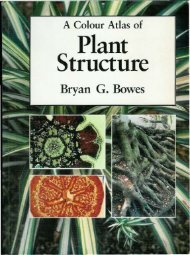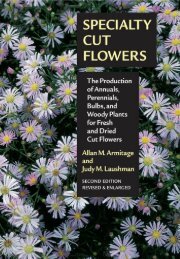You also want an ePaper? Increase the reach of your titles
YUMPU automatically turns print PDFs into web optimized ePapers that Google loves.
amino acidsalpha helix A highly stable structure inwhich peptide chains are coiled to form aspiral. Each turn <strong>of</strong> the spiral contains approximately3.6 amino acid residues. <strong>The</strong>R group <strong>of</strong> these amino acids extends outwardfrom the helix. Hydrogen bondingbetween successive coils holds the helix together.If the alpha helix is stretched thehydrogen bonds are broken but reform onrelaxation. <strong>The</strong> alpha helix is found inmuscle protein and keratin.alpha-naphthol test (Molisch’s test) Atest for detecting the presence <strong>of</strong> carbohydratesin solution. <strong>The</strong> test solution isplaced in a test tube, and a small amount <strong>of</strong>alpha-naphthol added; concentrated sulfuricacid is then trickled slowly down theside <strong>of</strong> the tube. If carbohydrate is present,a violet ring will form at the junction <strong>of</strong> theliquids.alpine Describing a BIOME (regionalcommunity) <strong>of</strong> plants above the treelineand below the snowline on high mountains.<strong>The</strong> lower limit <strong>of</strong> the alpine zonevaries in different mountain regions, accordingto the rainfall and other climaticand topographic factors, from 100 metersabove sea level in parts <strong>of</strong> Scotland to 3700meters in the western Himalayas. <strong>The</strong>re are<strong>of</strong>ten considerable differences between thenature and distribution <strong>of</strong> vegetation onnorth- and south-facing slopes and betweenwindward and leeward slopes.Alpine vegetation is <strong>of</strong>ten similar to TUN-DRA vegetation, being adapted to harsh climateconditions, including high windspeeds.alternate Describing a leaf arrangementin which there is only one leaf at each node,as in hazel. This is the commonest form <strong>of</strong>leaf arrangement. See phyllotaxis.alternate host Any host other thanthe main (most common) one. For example,many rusts overwinter on alternatehosts. Some parasites and pests are able tolive on more than one host, and someneed a second host to complete their lifecycle.alternation <strong>of</strong> generations <strong>The</strong> occurrence<strong>of</strong> two, or occasionally more, generationsduring the life cycle <strong>of</strong> an organism.In all plants and some algae there is an alternationbetween sexual haploid andasexual diploid stages. <strong>The</strong>y usually differmarkedly in morphology. <strong>The</strong> haploidplant produces gametes mitotically and isthus termed the gametophyte while thediploid plant produces spores meioticallyand is called the sporophyte. <strong>The</strong> gametesfuse to form a zygote, which develops intothe sporophyte, and the spores germinateand produce the gametophyte, so forminga cycle. In bryophytes (mosses, liverwortsand hornworts) the haploid gametophyte isthe dominant phase <strong>of</strong> the life cycle and thesporophyte is represented only by the capsule,seta, and foot. In vascular plants thediploid sporophyte is the dominant phaseand in the ferns, for example, the gametophyteis a small prothallus. <strong>The</strong> concept <strong>of</strong>an alternation <strong>of</strong> generations can be extendedto the flowering plants, in which theembryo sac and pollen represent the muchreduced female and male gametophyte generationsrespectively.ameboid Describing an organism thatresembles an ameba in shape and movement.amensalism An association betweentwo different species, at either the level <strong>of</strong>the individual organism or the populationlevel, in which one is harmed and the otheris unaffected. Compare commensalism;mutualism.amino acids Compounds containingboth carboxylic acid and amino groups intheir molecules. <strong>The</strong> amino acids have thegeneral formula RCHNH 2 –COOH. Here,the group R ranges from a simple hydrogenatom to complex ring structures. All aminoacids are white, crystalline, soluble inwater, and with the sole exception <strong>of</strong> thesimplest member, glycine, all are opticallyactive.Amino acids are the basic components<strong>of</strong> proteins, which consist <strong>of</strong> chains <strong>of</strong>amino acids. Plants also contain some 20011





